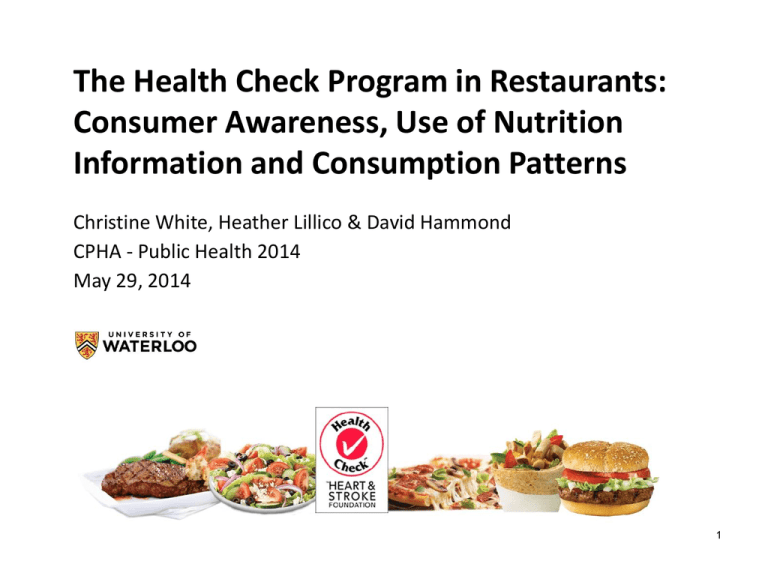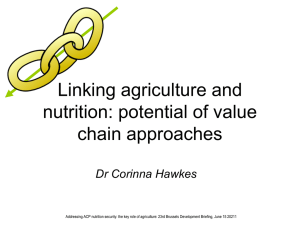
The Health Check Program in Restaurants:
Consumer Awareness, Use of Nutrition
Information and Consumption Patterns
Christine White, Heather Lillico & David Hammond
CPHA - Public Health 2014
May 29, 2014
1
Obesity and Eating out
• 60% of Canadian adults obese or overweight.1
• Increased energy intake has been driven in part
by greater caloric intake outside the home.2,3
• More than half of Canadians eat at least one meal
prepared out of the home each day.4
Sources:
1. Tjepkema M. Measured Obesity Adult obesity in Canada: Measured height and weight. Nutrition: Findings from the Canadian Community Health Survey. Ottawa,
ON; Statistics Canada, November, 2008.
2. French SA, Harnack L, Jeffery RW. Fast food restaurant use among women in the Pound of Prevention study: dietary, behavioral and demographic correlates.
International Journal of Obesity 2000; 24:1353-1359.
3. World Health Organization. Obesity and overweight: Facts. Available at: http://www.who.int/dietphysicalactivity/publications/facts/obesity/en/print.html
4. Canadian Council of Food and Nutrition. Tracking Nutrition Trends VII. August 2008.
2
Menu Labelling Regulations
3
Photo Credit: http://life.nationalpost.com/2014/02/24/calorie-counts-on-fast-food-menus-coming-to-ontario-as-liberal-government-promises-nutrition-labelling-bill/
Menu Labelling Regulations - Canada
Source:
1. The Globe and Mail. Ontario to require chain restaurants to serve up calorie counts. Available at:
http://www.theglobeandmail.com/news/national/ontario-to-move-ahead-with-calorie-counts-on-fast-food-chain-menus/article17063860/
4
Availability of nutrition information Quick-service 2012
•
26% had “any” nutrition information on menu
•
53% had nutrition information on back of tray liner
Source:
Hobin E, Lebenbaum M, Rosella L, Hammond D. Availability, format, and type of on-premise nutrition information in the top 10 fast-food chain restaurants in Canada. Submitted, 2013.
5
Voluntary Policies
• Informed Dining program
• Heart & Stroke Foundation’s Health Check program
Sources:
1. The Province of British Columbia. Informed Dining. Available at: https://www.healthyfamiliesbc.ca/home/informed-dining
2. Heart and Stroke Foundation. (2014). Health Check Can Help – Eating Out. http://www.healthcheck.org/page/health-check-can-help-eating-out
6
The Health Check Program
Designed to help consumers identify healthy
foods in grocery stores and restaurants
Items that meet nutrition
criteria are identified with
the Health Check symbol
Sources:
1. Heart and Stroke Foundation. (2014). Health Check Can Help – Eating Out. http://www.healthcheck.org/page/health-check-can-help-eating-out
7
The Health Check Program
Nutrition criteria are based on Canada’s Food Guide
and are developed by registered dietitians.
Menu items are evaluated on fat (quantity and type),
fibre, sodium, protein, vitamin and mineral content.
Separate criteria for different menu categories
(e.g., small entrées, large entrées, soups, salads,
appetizers, pizza, children’s entrées)
Sources:
1. Heart and Stroke Foundation. (2014). Health Check Can Help – Eating Out. http://www.healthcheck.org/page/health-check-can-help-eating-out
2. Heart and Stroke Foundation. (2014). Health Check Nutrient Criteria – Foodservice: October 2013. Available at:
http://www.healthcheck.org/sites/default/files/mmallet/HC13_NutrientCriteria_foodservice_%20october%202013_English.pdf
8
Research Objectives
Compare restaurants participating in the Health Check
program vs. other restaurants
• Does consumer awareness of nutrition information
differ by restaurant type?
• Does use of nutritional information (including the
Health Check symbol) differ by restaurant type?
• Do nutrient consumption patterns differ by restaurant
type?
9
Methods
Exit surveys with 1,126 patrons outside 4 Health Check
restaurants and 4 comparison restaurants
Restaurants matched on menu (burger, pizza, pita, grill)
Data collection: May – June 2013
Eligibility criteria:
• 18 years or older
• Purchased food/drink at restaurant
• Dine-in only (except at pita and pizza restaurants)
10
Measures
Noticing Nutrition Information
Did you notice any nutrition information anywhere
in the restaurant today? (yes/no)
Where was this information located?
• e.g., on the menu, next to food item
What type of nutrition information did you notice?
• e.g., calories, fat, Health Check logo
11
Measures
Use of Nutrition Information
Did the nutrition information influence what you
ordered? (yes/no)
How did the nutrition information influence what you
ordered?
•
e.g., ordered a smaller size, ordered “healthier” items,
chose items with less calories
12
Measures
Nutrient Consumption
Food order:
•
Entrées, sides, drinks, appetizers/desserts,
complimentary items, modifications (open-ended)
•
Adjusted for whether they finished their meal
Nutritional content:
•
Calories, fibre, protein, sodium, carbohydrate and fat
•
Values for each item obtained from restaurant
websites and Canadian Nutrient File
13
Analysis
Chi-square tests and t-tests
•
Test sample differences
Logistic and linear regression models:
•
Health Check vs. Comparison Outcomes
•
Odds ratios adjusted for age, sex, education, income,
race, BMI, fruit and vegetable consumption, weight
aspiration, and perceived overall diet quality
14
Sample Characteristics (n=1,126)
Health Check
(n=589)
Comparison
(n=537)
43 yrs
40 yrs
50%
51%
High school or less
29%
27%
Some college/university
35%
39%
University degree or higher
36%
32%
< $50,000
16%
18%
$50,000 - $90,000
23%
21%
> $90,000
37%
37%
Not stated
25%
24%
Characteristic
Mean age*
% Male
Education
Income
*p<0.05
15
Noticing Nutrition Information
Did you notice any nutrition information
anywhere in the restaurant today? (N=1,126)
34.2%
Health Check
28.1%
Comparison
(OR=0.72, p=0.019)
16
Noticing Nutrition Information
Where did you notice nutrition information? (N=1,126)
Health Check
Comparison
(n=589)
(n=537)
21.6%
9.3%
Poster
5.1%
6.5%
Wall/window/door
5.6%
5.0%
Pamphlet*
1.9%
5.0%
Napkin
3.9%
-
Next to food item*
1.5%
3.5%
Wrapper
0.7%
0.4%
Tray liner
0.7%
0.7%
Menu/menu board*
*p<0.05
17
Noticing Nutrition Information
What type of information did you notice? (N=1,126)
Health Check
Comparison
(n=589)
(n=537)
23.8%
15.3%
9.2%
7.1%
5.3%
1.3%
Sodium / Salt
3.9%
1.3%
Sugar / Carbohydrates
2.2%
1.3%
“Other” health symbol
0.5%
2.6%
Other
8.6%
5.2%
Calories
Fat
Health Check logo
18
Use of Nutrition Information
Did the nutrition information influence
what you ordered? (N=1,126)
10.9%
Health Check
4.5%
Comparison
(OR=0.34, p<0.001)
19
Health Check Symbol
Do you recognize this symbol? (n=589)
Yes:
91.0%
20
Health Check Symbol
Did any of the items you ordered today
have this symbol? (N=1,126)
21
Health Check Symbol
Did any of the items you ordered today
have this symbol? (N=1,126)
Health Check restaurants = 7.5%
p<0.01
22
Health Check Symbol
Among those who reported ordering a
Health Check approved item:
(among those at Health Check restaurants)
22% “symbol influenced their p<0.01
choice”
23
Ordering Health Check Items
•
15% ordered at least 1 Health Check approved item (n=87)
•
~1% ordered a Health Check item and recalled seeing
symbol (unprompted recall) (n=8)
•
<4% ordered a Health Check item and were aware it
was Health Check approved (when asked directly) (n=23)
•
<2% ordered a Health Check item, were aware it was
Health Check approved, and said the symbol influenced
their order (n=13)
24
Nutrient Consumption
Mean nutrients consumed in meal (includes beverage)
*
* p<0.05
25
Nutrient Consumption
Mean nutrients consumed in meal (includes beverage)
*
*
*
* p<0.05
26
Summary
Health Check program is associated with:
• Greater levels of noticing and using nutrition
information when selecting meals
• More favourable nutrient intake
Unclear if effects attributable to the program or reflect
the type of restaurants that “self-select” into the program
Findings suggest modest impact of voluntary nutrition
labelling in the restaurant
27
Strengths & Limitations
Naturalistic environment
Assumptions required when calculating food & nutrient
consumption
Self-reported data
28
Future Research
Natural policy experiments
“No policy” vs. Voluntary vs. Mandatory policies
29
Photo Credit: https://www.healthyfamiliesbc.ca/about-us/informed-dining-national : /
Funding support
National Institutes of Health Grant # 1 P01 CA138-389-01 - Hammond
CCSRI Junior Investigator Award Hammond
CIHR New Investigator Award Hammond
30
Contact
Christine White, MSc
School of Public Health & Health Systems
University of Waterloo
Tel.
519 888 4567 ext.36525
Email c5white@uwaterloo.ca
31









